MARKET OVERVIEW
In the rapidly advancing medical technology, the Global Robot Assisted Percutaneous Coronary Intervention (PCI) market stands as a testament to the profound impact of innovation on healthcare practices. Robot-assisted PCI, a groundbreaking field, marries precision engineering with medical expertise to revolutionize the way coronary interventions are conducted. The technology addresses the challenges inherent in traditional PCI procedures, offering a glimpse into the future of interventional cardiology.
The Global Robot Assisted PCI market represents a transformative approach to coronary interventions, driven by the integration of robotic systems into the catheterization lab. These sophisticated robotic platforms empower healthcare professionals by providing them with enhanced control and precision during PCI procedures. The utilization of robotic assistance aims to overcome the limitations associated with human dexterity and opens new avenues for optimizing patient outcomes.
One of the defining features of the Robot Assisted PCI market is the seamless collaboration between skilled physicians and advanced robotic systems. The synergy between human expertise and technological capabilities results in improved procedural accuracy, reduced radiation exposure, and enhanced overall safety for both patients and medical staff. The market’s trajectory is guided by a commitment to augmenting the capabilities of healthcare professionals rather than replacing them, underscoring the symbiotic relationship between man and machine.
The growing adoption of robot-assisted PCI is driven by its potential to overcome challenges inherent in traditional procedures, such as navigating complex vascular structures with precision and performing delicate maneuvers. As healthcare providers witness the tangible benefits of improved procedural outcomes and reduced patient recovery times, the market gains momentum, positioning itself as a pivotal player in the evolving landscape of interventional cardiology.
Beyond the immediate advantages in procedural precision, the Global Robot Assisted PCI market also contributes to the optimization of healthcare resources. By streamlining workflows and enhancing procedural efficiency, these robotic systems enable medical facilities to accommodate a higher volume of patients, ultimately bolstering the scalability of cardiovascular care. This shift towards efficiency aligns with the broader trends in healthcare, where technological innovations are harnessed to improve patient access and optimize resource utilization.
The Global Robot Assisted PCI market represents a paradigm shift in interventional cardiology, where the fusion of human skill and technological precision redefines the boundaries of what is achievable in coronary interventions. As this market continues to evolve, its impact on patient outcomes, procedural efficiency, and the overall landscape of healthcare is poised to be both profound and enduring, marking a new era in the pursuit of excellence in cardiovascular care.
Global Robot Assisted PCI market is estimated to reach $144.3 Million by 2030; growing at a CAGR of 23.9% from 2023 to 2030.
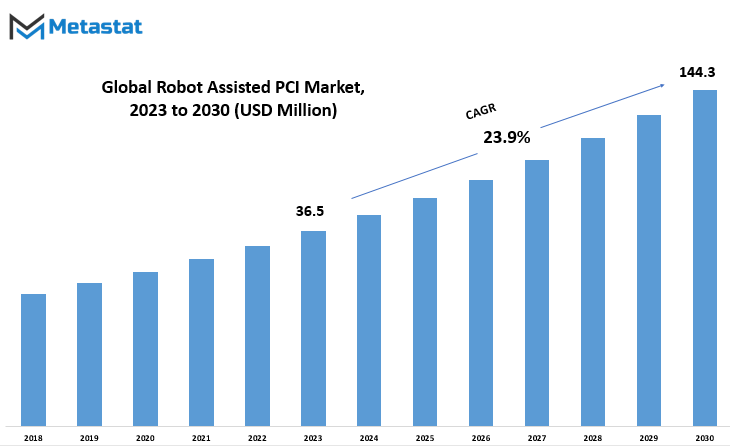
GROWTH FACTORS
The Global Robot Assisted PCI market is propelled by several growth factors that are pivotal in shaping its trajectory. These factors serve as key drivers, steering the market towards expansion and innovation. However, it's essential to acknowledge that challenges exist, posing potential obstacles to the market's growth. Among these challenges, certain factors might exert a dampening effect on the market's progress.
The driving forces behind the growth of the Global Robot Assisted PCI market are instrumental in its dynamic evolution. These factors, which fuel the market's momentum, contribute to its resilience and capacity for innovation. They lay the foundation for advancements and breakthroughs that redefine the landscape of robot-assisted percutaneous coronary intervention.
On the flip side, challenges loom on the horizon, potentially hindering the seamless growth of the market. It's crucial to recognize these obstacles as they can influence the market dynamics and necessitate strategic adaptations. Addressing these challenges becomes imperative to sustain the market's upward trajectory.
Despite the challenges, the market landscape is not devoid of opportunities. Within the confines of challenges lie prospects for growth and development. Identifying and capitalizing on these opportunities is pivotal for the market to navigate hurdles successfully and emerge stronger. The ability to discern lucrative prospects ensures the market's adaptability and resilience in the face of challenges.
The Global Robot Assisted PCI market operates within a framework where growth factors propel its advancement, challenges pose hurdles, and opportunities present avenues for development. Navigating this dynamic landscape requires a nuanced understanding of the interplay between these elements. By leveraging growth factors, addressing challenges, and seizing opportunities, the market can chart a course of sustainable growth in the years to come.
MARKET SEGMENTATION
By Product Type
In the Global Robot Assisted PCI market, the product offerings play a pivotal role in delineating the market's dynamics. The market, with its diverse applications and technologies, can be distilled into three primary product types: Robotic Systems, Instruments, and Accessories.
At the forefront are Robotic Systems, representing the technological backbone of the market. These systems bring automation and precision to Percutaneous Coronary Intervention (PCI) procedures, revolutionizing the way cardiovascular interventions are conducted. The emphasis here is on the integrated robotic solutions that assist healthcare professionals in navigating complex cardiac procedures with enhanced accuracy.
Complementing the robotic systems are Instruments, a category designed to perform specific functions within the PCI process. These instruments, intricately designed and calibrated, serve as the hands of the robotic systems, executing precise maneuvers guided by advanced technologies. Their role is integral in ensuring the success and effectiveness of robot-assisted PCI procedures.
The market encompasses Accessories, a category that augments the overall functionality and usability of robotic systems and instruments. Accessories include a range of components, from disposables to additional tools, enhancing the adaptability and efficiency of the robot-assisted PCI setup. These elements contribute to the holistic nature of the robotic-assisted intervention, addressing specific needs and challenges encountered during procedures.
The segmentation of the Global Robot Assisted PCI market into these distinct product types mirrors the market's adaptability to cater to a spectrum of requirements. Whether through the integrated systems orchestrating precise interventions, the specialized instruments executing intricate tasks, or the accessories fine-tuning the overall process, each product type plays a vital role in advancing the capabilities of robot-assisted PCI procedures.
The product segmentation of Robotic Systems, Instruments, and Accessories defines the Global Robot Assisted PCI market's structure and functionality. Together, these elements form a cohesive ecosystem that empowers healthcare professionals to conduct PCI procedures with unprecedented precision and efficiency, marking a significant stride in the field of cardiovascular interventions.
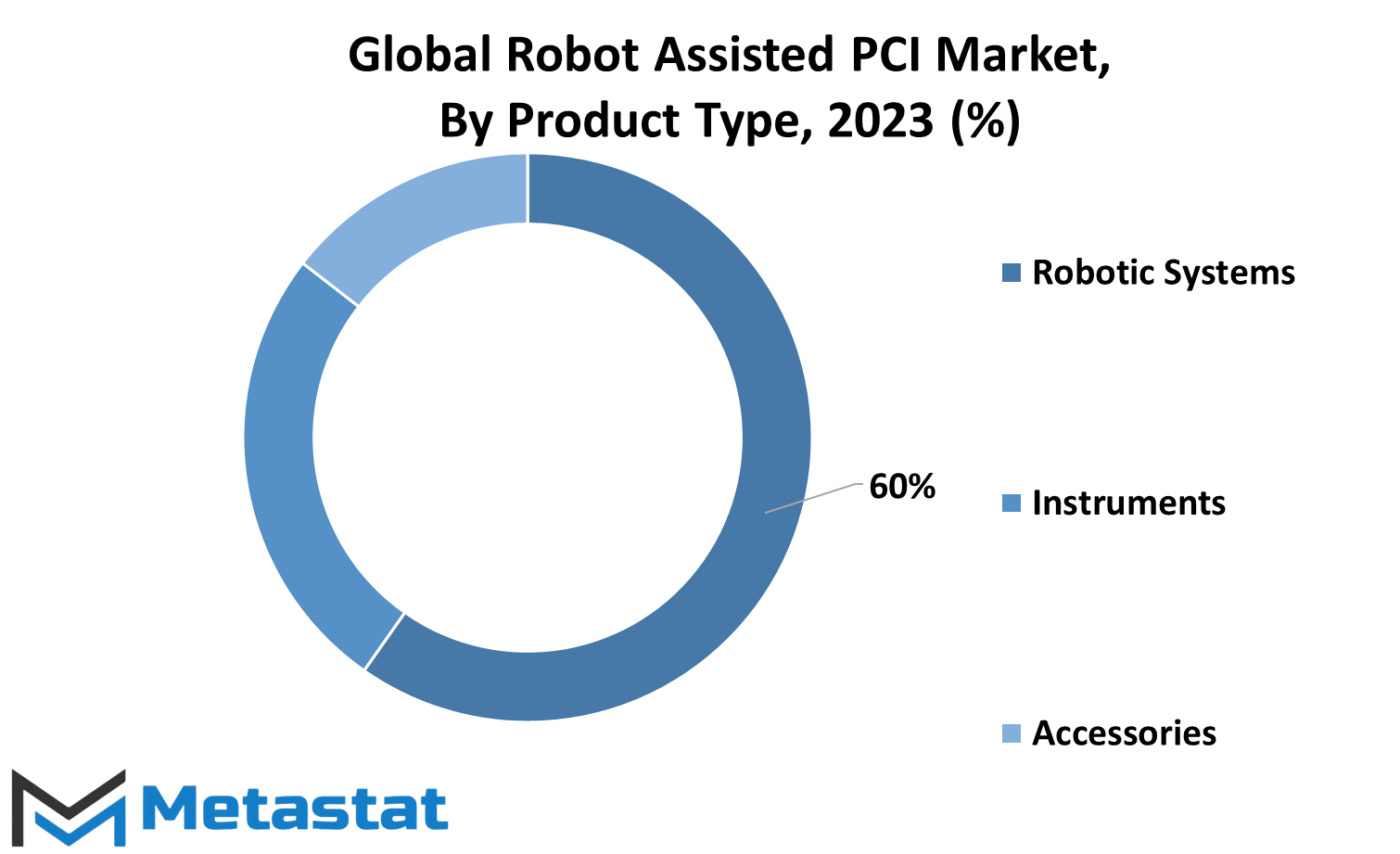
By End User
The Global Robot Assisted PCI market’s end-users delineate distinct sectors benefiting from this innovative technology. Hospitals, a crucial component, held a value of 25.6 USD Million in 2024, underscoring their pivotal role in adopting Robot Assisted PCI for advanced medical procedures. The Cath Labs segment, valued at 12.1 USD Million in the same period, signifies a specific domain within healthcare, highlighting the targeted application of this technology.
Beyond these, the Others segment, valued at 4.66 USD Million in 2024, encapsulates a variety of entities incorporating Robot Assisted PCI for their unique needs. These could range from smaller medical facilities to specialized clinics, showcasing the versatility of this technology across diverse healthcare settings.
This market segmentation reflects not only the widespread adoption of Robot Assisted PCI but also its adaptability to varying requirements. Hospitals, as the primary end-users, harness the technology for a broad spectrum of medical interventions, while Cath Labs focus on specialized cardiac procedures. The Others segment caters to a range of establishments, emphasizing the technology's accessibility and relevance across the healthcare spectrum.
The Global Robot Assisted PCI market doesn't confine itself to a singular application. It caters to a diverse array of end-users, each contributing to the market's growth. As hospitals, Cath Labs, and others continue to integrate Robot Assisted PCI into their practices, it becomes evident that the impact of this technology extends across various facets of the healthcare landscape, enriching medical practices and contributing to the advancement of patient care.
REGIONAL ANALYSIS
The Global Robot Assisted PCI market, in terms of geography, exhibits a division that spans across different regions worldwide. This division is essential for understanding the market's reach and impact, with North America and Europe being key players in this expansive landscape.
North America, a significant hub for technological advancements and innovations, holds a noteworthy position in the global Robot Assisted PCI market. The region's robust infrastructure, coupled with a tech-savvy population, has contributed to the substantial growth of Robot Assisted PCI technologies. This growth is reflected in the market dynamics, making North America a crucial market player.
Similarly, Europe, with its developed economies and emphasis on cutting-edge technologies, is a pivotal contributor to the global Robot Assisted PCI market. The region's healthcare sector, known for its progressive approach, has embraced robotic-assisted procedures, including PCI. This adoption fuels the market's momentum, solidifying Europe's standing in the global landscape.
The division of the market into these regions provides valuable insights into the varied dynamics at play. The influence of technological landscapes, healthcare infrastructures, and regional preferences becomes evident, shaping the trajectory of the Robot Assisted PCI market. As these regions continue to drive advancements in medical technology, their roles in the global market are set to evolve, shaping the future landscape of Robot Assisted PCI on a worldwide scale.
COMPETITIVE PLAYERS
In the Global Robot Assisted PCI market, key players play a pivotal role in shaping the industry's trajectory. Among them, Siemens Healthcare Private Limited and Robocath stand out as prominent contributors to the field. These companies bring their expertise and innovations to the realm of Robot Assisted PCI, influencing the market's dynamics.
Siemens Healthcare Private Limited, with its established presence, brings a wealth of experience and technological prowess to the table. The company's contributions to the Robot Assisted PCI market are underscored by a commitment to advancing healthcare technologies. Their impact is felt through cutting-edge solutions that enhance the precision and efficiency of percutaneous coronary interventions.
Robocath, another significant player, brings a focused and innovative approach to Robot Assisted PCI. Their contributions reflect a dedication to pushing the boundaries of interventional cardiology. By leveraging robotics, Robocath aims to redefine the standards of precision and safety in percutaneous coronary interventions, ultimately improving patient outcomes.
These key players not only bring technological advancements to the forefront but also contribute to the overall growth and competitiveness of the Robot Assisted PCI market. Their presence signifies a commitment to addressing the evolving needs of healthcare, aligning with the industry's drive for innovation and enhanced patient care.
As the global demand for advanced medical interventions continues to rise, the roles of Siemens Healthcare Private Limited and Robocath become increasingly vital. Their contributions extend beyond individual market shares, influencing the collective trajectory of the Robot Assisted PCI industry. In this dynamic landscape, these key players navigate the intersection of technology and healthcare, steering the industry towards new frontiers of possibility.
Robot Assisted PCI Market Key Segments:
By Product Type
- Robotic Systems
- Instruments
- Accessories
By End User
- Hospitals
- Cath Labs
- Others
Key Global Robot Assisted PCI Industry Players
WHAT REPORT PROVIDES
- Full in-depth analysis of the parent Industry
- Important changes in market and its dynamics
- Segmentation details of the market
- Former, on-going, and projected market analysis in terms of volume and value
- Assessment of niche industry developments
- Market share analysis
- Key strategies of major players
- Emerging segments and regional growth potential



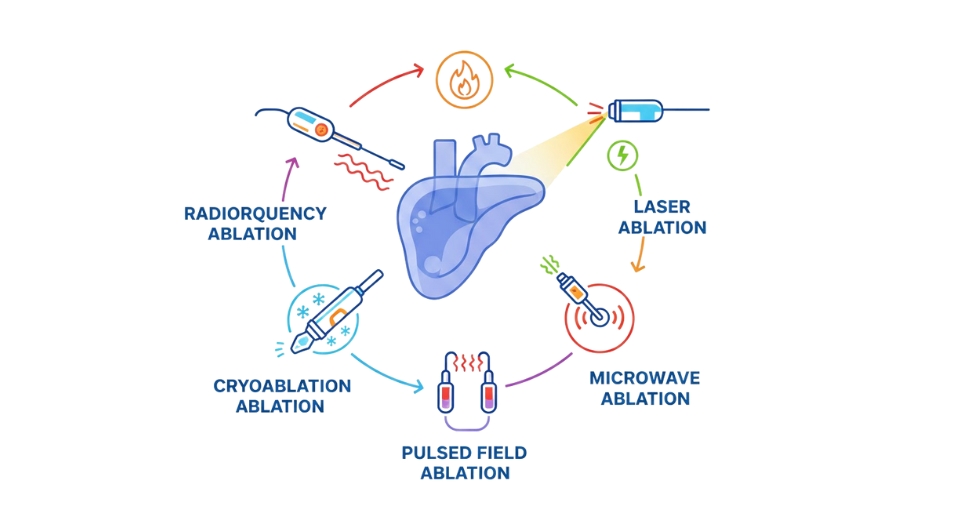

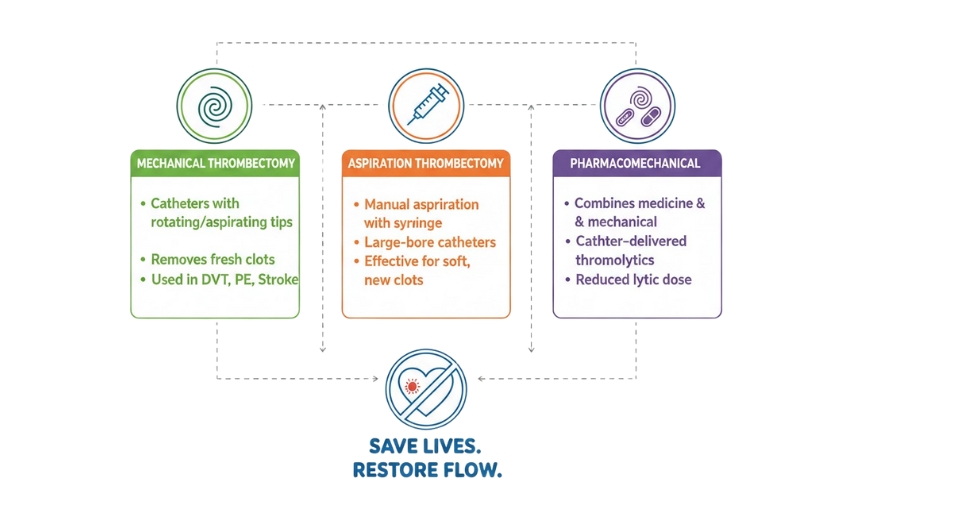
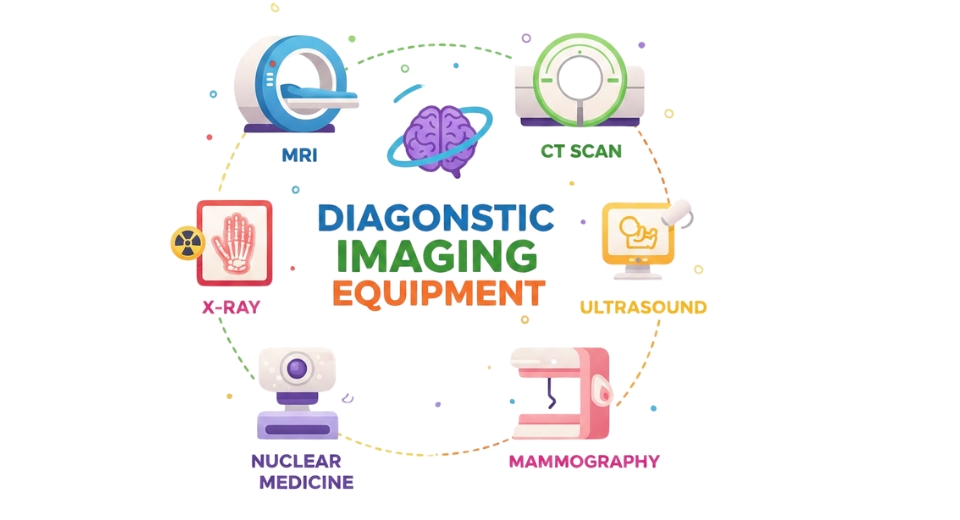

 US: +1 3023308252
US: +1 3023308252






